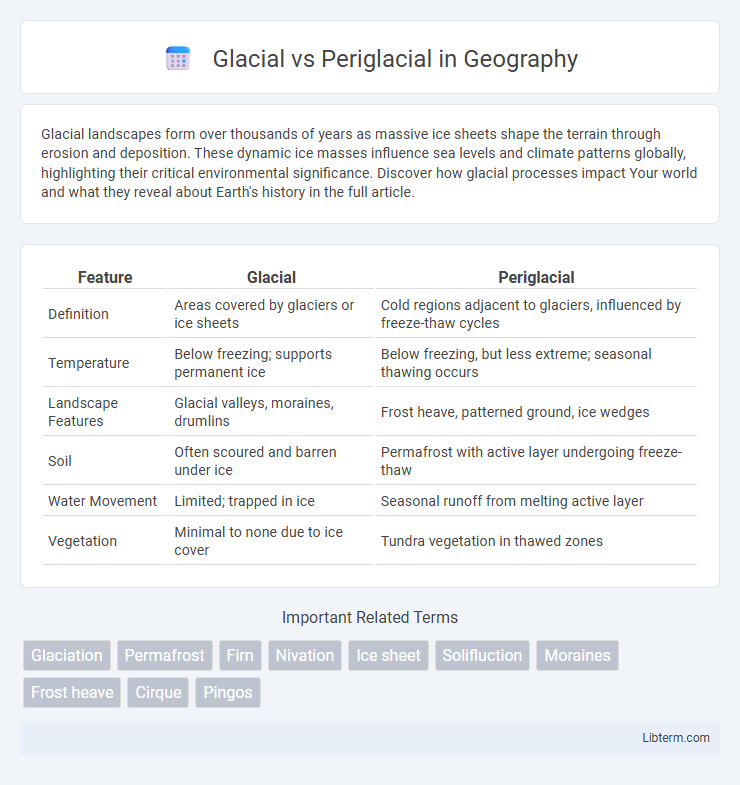Glacial landscapes form over thousands of years as massive ice sheets shape the terrain through erosion and deposition. These dynamic ice masses influence sea levels and climate patterns globally, highlighting their critical environmental significance. Discover how glacial processes impact Your world and what they reveal about Earth's history in the full article.
Table of Comparison
| Feature | Glacial | Periglacial |
|---|---|---|
| Definition | Areas covered by glaciers or ice sheets | Cold regions adjacent to glaciers, influenced by freeze-thaw cycles |
| Temperature | Below freezing; supports permanent ice | Below freezing, but less extreme; seasonal thawing occurs |
| Landscape Features | Glacial valleys, moraines, drumlins | Frost heave, patterned ground, ice wedges |
| Soil | Often scoured and barren under ice | Permafrost with active layer undergoing freeze-thaw |
| Water Movement | Limited; trapped in ice | Seasonal runoff from melting active layer |
| Vegetation | Minimal to none due to ice cover | Tundra vegetation in thawed zones |
Understanding Glacial and Periglacial Environments
Glacial environments are characterized by the presence of permanent ice masses, such as glaciers and ice sheets, which actively shape landscapes through processes like erosion and deposition. Periglacial environments occur in cold regions adjacent to glaciers, where freeze-thaw cycles and ground ice dynamics dominate, influencing soil structure and vegetation patterns. Understanding these environments involves studying temperature fluctuations, geomorphological features, and the impact of climate change on ice stability and permafrost integrity.
Key Differences Between Glacial and Periglacial Processes
Glacial processes involve the movement and melting of large ice masses, such as glaciers and ice sheets, shaping landscapes through erosion, deposition, and the formation of features like moraines and drumlins. Periglacial processes occur in cold, non-glacial environments where freeze-thaw cycles dominate, leading to phenomena such as frost heaving, patterned ground, and solifluction. The key difference lies in glacial environments being directly influenced by ice flow, whereas periglacial areas experience intense freeze-thaw weathering and soil dynamics without permanent ice coverage.
Glacial Landscapes: Features and Formation
Glacial landscapes are shaped by the movement and melting of glaciers, which carve distinctive features such as U-shaped valleys, fjords, and moraines through erosion and deposition. These landscapes often exhibit striations and drumlins, indicating past glacial activity and ice flow direction. The formation process involves the accumulation and compaction of snow into ice, which then advances under gravity, sculpting the terrain beneath.
Periglacial Landscapes: Characteristics and Development
Periglacial landscapes develop in regions adjacent to glaciers, characterized by intense freeze-thaw cycles that shape the land through processes such as frost heaving and solifluction. These environments feature distinctive landforms like patterned ground, ice wedges, and pingos, which result from the seasonal freezing and thawing of permafrost. Soil and sediment in periglacial areas undergo constant mechanical weathering, influencing ecosystem dynamics and hydrological patterns distinct from glacially carved terrains.
Climate Requirements for Glacial vs Periglacial Areas
Glacial areas require consistently low temperatures below freezing, typically found in polar and high-altitude regions where ice masses accumulate and persist year-round. Periglacial zones experience cold but fluctuating temperatures, generally between -10degC and 0degC, supporting freeze-thaw cycles without permanent ice cover. These climates foster distinctive landforms: glaciers develop in stable cold environments, while periglacial regions exhibit patterned ground and soil frost due to seasonal temperature variations.
Common Landforms in Glacial Regions
Glacial regions commonly feature landforms such as U-shaped valleys, fjords, and moraines, formed by the direct movement and melting of glaciers. These areas also exhibit features like drumlins and glacial erratics, which result from ice sheet activity and sediment deposition. The unique topography of glacial landscapes reflects the powerful erosive and depositional forces of glacier dynamics.
Typical Landforms in Periglacial Zones
Periglacial zones are characterized by distinct landforms such as patterned ground, ice wedges, and pingos, resulting from freeze-thaw cycles and soil freezing processes. Solifluction lobes and frost heave structures are common, formed through repeated soil movement and expansion during cold periods. These features contrast with glacial landforms like moraines and drumlins, which are shaped primarily by ice movement.
Ecological Impact of Glacial and Periglacial Processes
Glacial processes shape ecosystems through the creation of unique habitats such as moraines, glacial lakes, and alpine tundra, influencing biodiversity and water availability. Periglacial processes, including freeze-thaw cycles and solifluction, lead to soil disturbance and patterned ground formation, affecting vegetation distribution and nutrient cycling in cold environments. Both processes play crucial roles in carbon storage and groundwater recharge, impacting global climate regulation and ecosystem resilience.
Human Activities in Glacial and Periglacial Regions
Human activities in glacial regions primarily include scientific research, tourism, and resource extraction such as mining and hydropower development, adapted to harsh cold environments with ice cover. In contrast, periglacial regions support more diverse land use including agriculture, settlement, and infrastructure development, as these areas generally experience seasonal freeze-thaw cycles and less permanent ice. Both regions face challenges from climate change impacts affecting ecosystem stability, permafrost integrity, and human infrastructure resilience.
Future Trends: Climate Change and Cryospheric Dynamics
Glacial and periglacial regions are experiencing accelerated transformations due to rising global temperatures, leading to altered ice mass balance and permafrost degradation. Future trends indicate increased glacial retreat and expanding periglacial landscapes, impacting hydrology, ecosystem dynamics, and carbon release from thawing permafrost. Cryospheric dynamics models predict intensified feedback loops between melting ice, greenhouse gas emissions, and regional climate variability, emphasizing the critical role of monitoring these environments for climate change mitigation strategies.
Glacial Infographic

 libterm.com
libterm.com